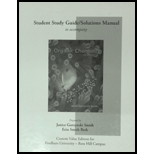
a) Which
b) Which
(a)
Interpretation: The
Concept introduction: The change in Gibbs free energy is represented by
If the
Answer to Problem 6.7P
The
Explanation of Solution
Given
The values of
The value of
The free energy change is calculated as,
Substitute the values of
The conversion of units of
The value of
Similarly, for
Substitute the values of
The conversion of units of
The value of
The
(b)
Interpretation: The
Concept introduction: The change in Gibbs free energy is represented by
If the
Answer to Problem 6.7P
The
Explanation of Solution
The value of
The free energy change is calculated as,
Substitute the values of
The conversion of units of
The value of
Similarly, for
Substitute the values of
The conversion of units of
The value of
Therefore, the
The
Want to see more full solutions like this?
Chapter 6 Solutions
Organic Chemistry -Study Guide / Solution Manual (Custom)
Additional Science Textbook Solutions
Organic Chemistry - Standalone book
Living By Chemistry: First Edition Textbook
Chemistry
Organic Chemistry
Principles of General, Organic, Biological Chemistry
Elementary Principles of Chemical Processes, Binder Ready Version
- For each process, predict whether entropy increases or decreases, and explain how you arrived at your prediction. 2 CO2(g) → 2 CO(g) + O2(g) NaCl(s) → NaCl(aq) MgCO3(s) → MgO(s) + CO2(g)arrow_forwardYeast can produce ethanol by the fermentation of glucose (C6H12O6), which is the basis for the production of most alcoholic beverages. C6H12O6(aq) 2 C2H5OH() + 2 CO2(g) Calculate rH, rS, and rG for the reaction at 25 C. Is the reaction product- or reactant-favored at equilibrium? In addition to the thermodynamic values in Appendix L, you will need the following data for C6H12O6(aq): fH = 1260.0 kl/mol; S = 289 J/K mol; and fG = 918.8 kl/mol.arrow_forwardIndicate whether the following processes are spontaneous or nonspontaneous. (a) Liquid water freezing at a temperature below its freezing point (b) Liquid water freezing at a temperature above its freezing point (c) The combustion of gasoline (d) A ball thrown into the air (e) A raindrop falling to the ground (f) Iron rusting in a moist atmospherearrow_forward
- Use S values to calculate the standard entropy change, rS0, for each of the following processes and comment on the sign of the change. (a) KOH(s) KOH(aq) (b) Na(g) Na(s) (c) Br2() Br2(g) (d) HCl(g) HCl(aq)arrow_forwardUse the data in Appendix G to calculate the standard entropy change for H2(g) + CuO(s) H2O() + Cu(s)arrow_forwardOn the basis of your experience, predict which reactions are spontaneous: (a) PbO2(s)Pb(s)+O2(g)(b) N2(l)N2(g) at 25C (c) C6H12O6(s)C6H12O6(l) at 25C (d) Ca2+(aq)+CO32(aq)CaCO3(s)arrow_forward
- What is the sign of the standard Gibbs free-energy change at low temperatures and at high temperatures for the synthesis of ammonia? 3H2(g) + N2(g) 2NH3(g)arrow_forwardUse the data in Appendix J to calculate rG andKPat 25 C for the reaction 2HBr(g)+Cl2(g)2HCl(g)+Br2() Comment on the connection between the sign of rG and the magnitude ofKP.arrow_forwarda Calculate K1, at 25C for sulfurous acid: H2SO3(aq)H+(aq)+HSO3(aq) b Which thermodynamic factor is the most significant in accounting for the fact that sulfurous acid is a weak acid? Why?arrow_forward
- Indicate which substance in the given pairs has the higher entropy value. Explain your choices.. (a) C2H5OH(l) or C3H7OH(l). (b) C2H5OH(l) or C2H5OH(g). (c) 2H(g) or H(g)arrow_forwardThe decomposition of diamond to graphite [C(diamond) C(graphite)] is thermodynamically favored, but occurs slowly at room temperature. a. Use fG values from Appendix L to calculate rG and Keq for the reaction under standard conditions and 298.15 K. b. Use fH and S values from Appendix L to estimate rG and Keq for the reaction at 1000 K. Assume that enthalpy and entropy values are valid at these temperatures. Does heating shift the equilibrium toward the formation of diamond or graphite? c. Why is the formation of diamond favored at high pressures? d. The phase diagram shows that diamond is thermodynamically favored over graphite at 20,000 atmospheres pressure (about 2 GPa) at room temperature. Why is this conversion actually done at much higher temperatures and pressures?arrow_forwardCalculate the entropy change, rS, for the vaporization of ethanol, C2H5OH, at its normal boiling point, 78.0 C. The enthalpy of vaporization of ethanol is 39.3 kJ/mol.arrow_forward
 Chemistry: The Molecular ScienceChemistryISBN:9781285199047Author:John W. Moore, Conrad L. StanitskiPublisher:Cengage Learning
Chemistry: The Molecular ScienceChemistryISBN:9781285199047Author:John W. Moore, Conrad L. StanitskiPublisher:Cengage Learning Chemistry & Chemical ReactivityChemistryISBN:9781133949640Author:John C. Kotz, Paul M. Treichel, John Townsend, David TreichelPublisher:Cengage Learning
Chemistry & Chemical ReactivityChemistryISBN:9781133949640Author:John C. Kotz, Paul M. Treichel, John Townsend, David TreichelPublisher:Cengage Learning Chemistry & Chemical ReactivityChemistryISBN:9781337399074Author:John C. Kotz, Paul M. Treichel, John Townsend, David TreichelPublisher:Cengage Learning
Chemistry & Chemical ReactivityChemistryISBN:9781337399074Author:John C. Kotz, Paul M. Treichel, John Townsend, David TreichelPublisher:Cengage Learning Chemistry by OpenStax (2015-05-04)ChemistryISBN:9781938168390Author:Klaus Theopold, Richard H Langley, Paul Flowers, William R. Robinson, Mark BlaserPublisher:OpenStax
Chemistry by OpenStax (2015-05-04)ChemistryISBN:9781938168390Author:Klaus Theopold, Richard H Langley, Paul Flowers, William R. Robinson, Mark BlaserPublisher:OpenStax Chemistry: Principles and PracticeChemistryISBN:9780534420123Author:Daniel L. Reger, Scott R. Goode, David W. Ball, Edward MercerPublisher:Cengage Learning
Chemistry: Principles and PracticeChemistryISBN:9780534420123Author:Daniel L. Reger, Scott R. Goode, David W. Ball, Edward MercerPublisher:Cengage Learning Chemistry: Principles and ReactionsChemistryISBN:9781305079373Author:William L. Masterton, Cecile N. HurleyPublisher:Cengage Learning
Chemistry: Principles and ReactionsChemistryISBN:9781305079373Author:William L. Masterton, Cecile N. HurleyPublisher:Cengage Learning





